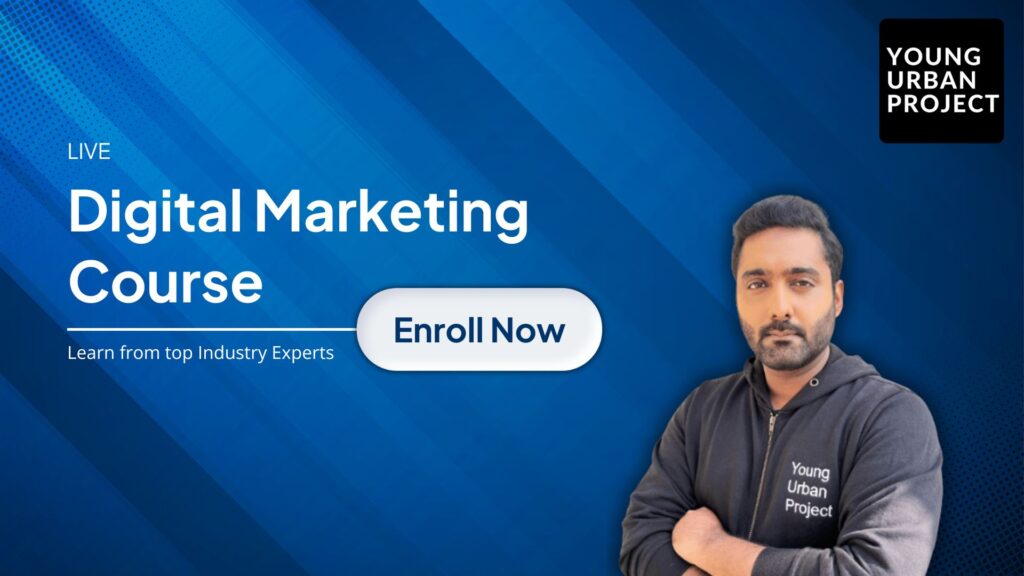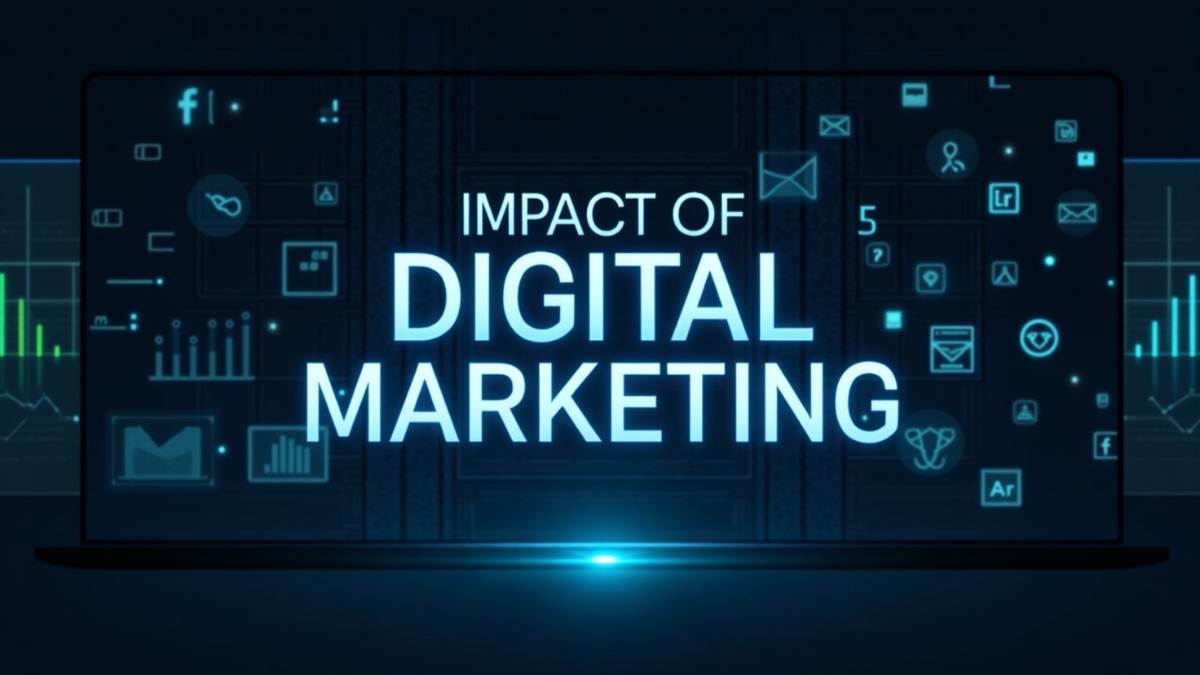It’s kinda wild how much things have changed, right? Not too long ago, if you wanted to promote your business, you’d put an ad in the newspaper, maybe hand out flyers, or if you had the budget – get a radio or TV spot. But now? Everything’s digital. And honestly, the impact of digital marketing is huge. It’s changed how businesses show up, how people find you, and even how they decide to trust (or ignore) you.
Whether you’re a local café, a freelance designer, or running a full-blown ecommerce brand, if you’re not using digital marketing, you’re basically invisible to half your audience. Maybe more. Let’s look at how we got here.
Table of Contents
Why Digital Marketing is a Game-Changer
Let’s face it – people live on their phones now.
They scroll, they search, they check reviews, watch videos, reply to stories… it’s constant. And that’s exactly where businesses need to be if they want to stay relevant.
1. The Rise of Online Consumers
Most of us don’t even think twice before Googling something or checking out a brand’s Instagram before buying. It’s just habit. Which means if your brand isn’t online, or if your presence sucks, people notice.
2. Everything’s Connected
People might see your product on TikTok, click to your website, get hit with an email a day later, then finally buy from a Facebook ad. It’s not a straight line. This is what we call omnichannel, and digital marketing makes it possible to connect the dots.
Also Read: Omnichannel Marketing Strategy
3. From Billboards to Clicks
Traditional marketing was kind of like shouting into the void. You’d spend a ton and just hope it worked. Now? You can run an ad, spend ₹500, and see how many people clicked, signed up, or bought something. You get data. You get control. That’s why digital has taken over.
Core Benefits of Digital Marketing for Modern Brands
So what makes digital marketing actually worth it? Here’s the real stuff:
1. Bigger Reach, Smarter Targeting
You’re not just blasting messages to random people. You can target exact age groups, interests, locations, heck, even people who visited your site but didn’t buy. It’s way more precise.
2. Way More Budget-Friendly
Let’s be honest, not everyone has lakhs to spend on ads. With digital, you can literally test things out with just a few hundred rupees. Small brands can finally play the game too.
3. Data Tells You What’s Working
You’re not guessing. You see what people clicked, where they dropped off, what made them convert. It’s like having cheat codes for your business decisions.
4. You Can Tweak Things Anytime
If something isn’t working, you don’t have to wait. You pause it, change the creative, test a new audience. You’re in the driver’s seat the whole time.
Key Digital Marketing Channels That Drive Results
There’s no one-size-fits-all in digital marketing. What works for one brand might flop for another. But here are the main marketing channels that are actually moving the needle for most businesses today:
- SEO (Search Engine Optimization) – Helps your brand show up when people search for things related to what you offer. Think Google rankings, blog traffic, and organic visibility.
- Social Media Marketing – From Instagram reels to LinkedIn posts to trending tweets, this is where you build community and vibe with your audience.
- Email & SMS Marketing – Super underrated. It’s direct, personal, and still one of the best ways to drive action, if done right.
- Content & Video Marketing – Blogs, YouTube, Shorts, guides, memes… basically all the stuff people consume when they’re not ready to buy but are curious.
- Paid Advertising – Google Ads, Meta Ads, YouTube pre-rolls, this is how you scale fast and get in front of people now.
- Influencer & Affiliate Marketing – Leveraging people with an audience to talk about your brand. Can work wonders if the trust is real.
- Mobile and App-Based Marketing – In-app notifications, mobile-friendly websites, and ads on platforms like Snapchat or Spotify, because everyone’s on their phones anyway.
The Real Impact of Digital Marketing on Business Growth
This is where things get interesting. Because digital marketing isn’t just about putting content out there, it’s about what happens because of it. Let’s break down the actual impact it has, starting with the stuff that matters most: engagement and leads.
A. Customer Engagement
This is all about how people interact with your brand, before they even think about buying.
1. Two-Way Conversations on Social Media
Back in the day, marketing was just brands talking at people. Now it’s a two-way thing. Someone comments? You reply. They tag you in a story? You reshare. They drop a DM? You have a conversation. This kind of back-and-forth builds connection, and honestly, it makes your brand feel human.
2. Personalization via Email and Content
Generic messages don’t cut it anymore. When someone gets an email that feels like it was written just for them, maybe with their name, product suggestions based on their past visits, or even a birthday coupon, it hits different. Same goes for blog content or videos that actually speak to where they are in the buying journey.
Also Read: What is Email Copywriting: Complete Guide
3. Interactive Elements Like Polls, Quizzes & Live Video
People don’t just want to watch, they want to interact. Polls on Instagram Stories, live Q&As, product quizzes that suggest the right fit… these small things get people to engage more, spend more time with your brand, and remember you later.
4. Retargeting That Keeps Users in the Funnel
You know those ads that follow you around after you visit a website? Yeah, those aren’t creepy, they’re effective. Retargeting reminds people you exist, shows them stuff they were already looking at, and nudges them to come back. It’s like giving them a gentle tap on the shoulder.
B. Lead Generation & Conversion
Now let’s talk about actually turning strangers into leads, and leads into buyers.
1. Funnel-Based Nurturing with Automation Tools
You don’t just throw people into a sales pitch anymore. Smart digital funnels guide them through stages, awareness, interest, decision, using content, emails, videos, whatever works. Tools like HubSpot, Mailchimp, or ConvertKit help automate this so things happen at the right time without you lifting a finger every day.
2. Paid Ads and Landing Pages for Instant Lead Capture
Let’s say someone clicks on your ad. Where they land matters a lot. A well-designed landing page with one clear goal, download this guide, book a demo, sign up for a webinar, can turn cold traffic into hot leads fast. Combine that with Facebook or Google lead forms and you’ve got a recipe for high-speed growth.
3. Micro-Conversions and User Journey Tracking
Not everyone will buy on day one. But they might download your free checklist. Or watch a video. Or sign up for emails. These little actions, called micro-conversions, are signs that someone’s warming up. With the right tools (like GA4 or Hotjar), you can see where people are in the journey and nudge them accordingly.
C. Brand Awareness & Positioning
Before people trust you, they need to know you. That’s where brand awareness comes in, and digital marketing makes it a whole lot easier (and cheaper) to get your name out there.
1. Organic Visibility via SEO and Content
When someone Googles a problem and your blog pops up with answers? That’s huge. You didn’t pay for that click, and yet you’re now on their radar. Writing useful content, optimizing your site, showing up in search, it all builds long-term visibility without burning ad spend.
2. Shareability Through Social Channels
If your content makes someone laugh, teaches them something, or just feels relatable, they’ll share it. And boom, now their friends see you too. That’s how a single post can reach hundreds (or thousands) without spending a rupee on ads. It’s slow at first, but it adds up.
3. Influence Through Storytelling and UGC
People don’t connect with logos, they connect with stories. Whether it’s a behind-the-scenes reel, a founder’s journey, or a customer review that just feels honest, these little moments shape how your brand is seen. And when your actual customers create content for you (UGC), it builds even more trust. Feels real. Because it is.
D. Sales & Revenue Growth
At the end of the day, all this marketing stuff needs to lead to sales. Otherwise, what’s the point, right?
1. E-commerce Integration and Checkout Journeys
If you sell online, your website or store needs to flow. Think fast load times, clean design, easy checkout. The fewer clicks it takes to buy something, the better. People bounce the second it gets frustrating, so optimizing this journey is key.
2. Performance Marketing That Ties Directly to ROI
This is where platforms like Meta Ads or Google Ads shine. You spend ₹1,000, you track how many clicks, how many conversions, how much revenue. You see exactly what you’re getting out of your spend. And if it’s not working? You change it. You test. You scale what works. No guesswork.
3. Attribution Modeling and Optimization
Sometimes it’s hard to know which touchpoint made someone buy. Was it the first Instagram ad? The blog they read later? The email you sent two days after? That’s where attribution comes in. Tools like Google Analytics try to map out the customer journey so you can give credit where it’s due, and make smarter decisions moving forward.
E. Customer Retention & Loyalty
Getting a customer is cool. Keeping them? That’s where the real money is.
1. Email Drip Campaigns and Re-Engagement
Once someone buys, don’t ghost them. Set up a series of follow-up emails, maybe with tips, how-tos, product suggestions, or just check-ins. You stay in their inbox, and in their mind. Plus, you can win back people who went cold with the right re-engagement offer.
2. Loyalty Programs Promoted Digitally
Give people a reason to come back. Whether it’s points, perks, early access, or little surprises, loyalty programs work. And when you promote them through email, SMS, or even in your packaging, you turn one-time buyers into repeat customers.
3. Consistent Post-Purchase Engagement
Send that “thank you” email. Ask for feedback. Drop in a how-to video. These little touches show that you care after the sale, which most brands honestly forget to do. It’s a small effort, but it builds long-term loyalty.

Enroll Now: Advanced Digital Marketing Course
Role of Data & Analytics in Maximizing Impact
1. How Insights Fuel Strategy
Guessing doesn’t cut it anymore. Data shows you what’s actually working, what people are clicking, buying, ignoring. It helps you double down on what drives results and ditch what doesn’t. The more you look at your numbers, the smarter your next move becomes.
2. Real-Time Dashboards and KPIs
No more waiting for monthly reports. Tools today show you what’s happening right now, how your ads are doing, how many visitors are dropping off, which page is killing it. And when you track the right KPIs daily, you can fix stuff before it’s too late.
3. Tools Like Google Analytics, HubSpot, Meta Insights
You don’t need fancy custom dashboards to get started. Google Analytics shows you what people do on your site. HubSpot helps track leads and automate follow-ups. Meta gives ad data. Learn these tools, they’re like a second brain for your business.
4. Personalization and Segmentation at Scale
Ever get an email that feels like it was written just for you? That’s segmentation in simple words. When you split your audience by behavior, location, or interests, your messages land better. Tools let you do this at scale, so it still feels personal, even when it’s not.
Challenges in Digital Marketing (And Smart Fixes)
1. Ad Fatigue and Content Overload
People scroll past a lot of stuff. If your ads look the same all the time, they’ll get ignored. Rotate creatives often, experiment with formats, and talk like a human, not a brand. Sometimes, even a raw selfie video performs better than a polished ad.
2. Algorithm Dependency and Policy Changes
One day your reach is great, the next it tanks. That’s the algorithm playing games. You can’t control it, but you can diversify, don’t rely on just one platform. Build email lists, push organic SEO, and don’t put your whole brand on rented land.
3. Data Privacy and Cookie Laws
Tracking is getting tougher. With cookies going away and privacy updates rolling out, businesses are losing data they used to rely on. The fix? Focus on first-party data, emails, purchase history, and engagement. Own your data instead of borrowing it.
4. How Brands Can Counteract These with Innovation
Instead of panicking, get creative. Use gamified content, interactive polls, or even community-driven campaigns. Lean into real storytelling. The brands that try new things, even if they flop sometimes, are the ones that stay top of mind.
Future Trends: How the Impact Will Evolve
1. AI, Automation, and Predictive Targeting
AI isn’t just hype anymore. It’s helping brands write emails, predict customer behavior, even run ads. You can automate what used to take hours. But the magic is in pairing AI with human creativity. Let the machine handle the boring bits, you do the thinking.
2. AR/VR and Immersive Content
We’re moving beyond flat screens. Augmented reality (AR) lets people try on products virtually. VR creates whole new worlds to experience your brand. It’s still early, but the brands that play here now will be way ahead in a couple of years.
3. Rise of Voice and Conversational Commerce
“Hey Alexa, order more coffee.” Voice search and voice commands are changing how people buy. On the other side, live chat and WhatsApp shopping make it easy for users to ask questions and purchase without ever leaving the convo. It’s all about ease.
4. Ethical & Sustainable Digital Marketing
People care about how brands behave. Are you using shady tactics? Bombarding inboxes? Ignoring sustainability? These things matter. Being transparent, ethical, and mindful in your campaigns isn’t just the right thing; it’s also good marketing.
Also Read: What Is Green Marketing?
Conclusion
Digital marketing isn’t something you can treat like an add-on anymore. It’s the core of how businesses grow today. The way people shop, search, scroll, it’s all digital. So if your brand’s not showing up there, you’re basically invisible.
The good news? You don’t need to do everything at once. Start where your audience is. Test what works. Keep learning because the brands that adapt will keep growing. The ones that don’t? They get left behind.
FAQs: Impact of Digital Marketing
1. What is the real impact of digital marketing on business?
It helps businesses reach more people, track what’s working, and grow faster, without burning huge budgets. From awareness to sales, every part of the customer journey can be optimized with digital.
2. How does digital marketing increase customer engagement?
It gives people ways to interact, likes, comments, emails, quizzes, DMs, live chats. Brands aren’t just talking at customers anymore, they’re actually having conversations and building relationships.
3. Which digital marketing channel is most effective in 2025?
Depends on your business, but honestly, SEO and paid ads still pull strong. Add in short-form video and email automation, and you’ve got a killer combo. No single channel wins alone, it’s how you mix them.
4. Can digital marketing help build long-term customer loyalty?
100%. With email campaigns, loyalty rewards, retargeting, and solid content, you can keep showing up even after the sale. People stay loyal to brands that feel consistent and actually care post-purchase.
5. How does data enhance the impact of digital marketing?
Data shows what’s working, what’s not, and what needs fixing. It helps you personalize messages, track results, and make smarter decisions. Without data, you’re just guessing. And guessing gets expensive.
6. What are the key trends shaping the future of digital marketing?
AI, voice search, immersive content (AR/VR), and ethical marketing are all big. But the biggest trend? Brands are getting more real. Less polish, more honesty. That’s what people connect with.

